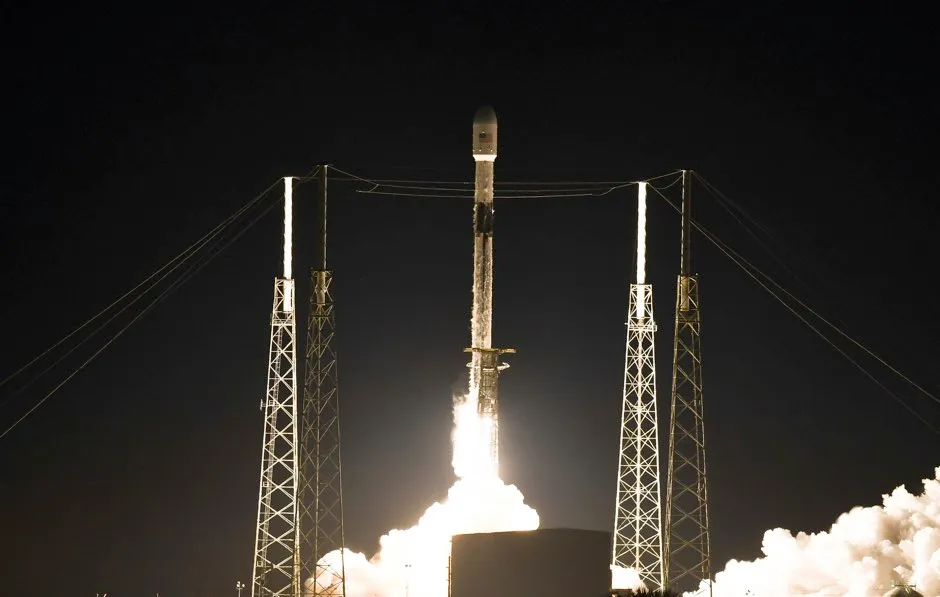SpaceX has launched 60 more mini internet satellites, this time testing a dark coating to appease stargazers.
It is a “first step” compromise between SpaceX and astronomers fearful of having dark skies spoiled by hundreds and, eventually, thousands of bright satellites circling overhead.
The Falcon 9 rocket blasted into a cold, clear night sky, recycled by SpaceX for its fourth flight.
As the first-stage booster flew to a vertical landing on an ocean platform, the Starlink satellites continued hurtling towards orbit to join 120 similar spacecraft launched last year.
Flight controllers applauded and the launch commentator described the booster’s fourth touchdown as “awesome”.
An hour later, all 60 satellites were free of their upper stage and making their own way in orbit.
“It’s a beautiful sight,” the commentator observed.

SpaceX founder and chief executive Elon Musk, whose Starlink fleet now numbers 180, plans to ultimately launch thousands of the compact flat-panel satellites to provide global internet service.
Each spacecraft weighs just 260kg.
After the first Starlink batch of 60 was launched in May and the second in November, astronomers complained how the bright satellite chain was hampering their observations.
In response, SpaceX came up with a darkening treatment to lessen reflectivity.
The coating is being tested on one of the newly launched satellites.
Read more about SpaceX:
- What is the environmental impact of the SpaceX Falcon Heavy launch?
- How does SpaceX Falcon compare to other rockets?
- Everything you need to know about SpaceX's Crew Dragon
Jeff Hall, director of the Lowell Observatory in Flagstaff, Arizona, said the Starlinks have been just an occasional problem so far but noted the risk to stargazing will grow as the constellation expands and other companies launch their own fleets.
He heads the American Astronomical Society’s committee on light pollution, space debris and radio interference, and is working with SpaceX on the issue.
The matter is on the agenda at the society’s conference in Hawaii this week.
“Anything that darkens the satellites is a step in the right direction,” Mr Hall said.
He said it is too soon to know whether the dark coating will work, “but it definitely is just a first step and not enough to mitigate the issues astronomy will experience with the Starlinks”.
The Starlinks are initially placed in a relatively low orbit of 290km, easily visible as a long, strung-out cluster parading through the night sky.
Over a few months, krypton-powered thrusters raise the satellites to a 550km orbit.
The higher the orbit, the less visible the satellites are from the ground, according to SpaceX.
Even so, SpaceX said it is supplying astronomy groups with the satellite co-ordinates in advance, so they can avoid the bright flyover times.
Reader Q&A: Does the debris around Earth affect the atmosphere?
Asked by: Ray Grech, Malta
There is no direct effect, although the density of space debris is now so great that astronomical observations are often degraded by it. The main problem is that of collisions with operational spacecraft. With an average impact speed of 10km/s, any piece of debris larger than 1cm in diameter can cause a catastrophic impact.
There are more than 100,000 such objects, including several dropped by astronauts during spacewalks, such as a camera, a glove and a pair of pliers. Most, however, have come from exploding rocket stages and satellites. The larger objects are tracked and spacecraft (including the space shuttle) occasionally have to manoeuvre to avoid them.
The main threat to our weather from space junk is rather indirect: the density of the junk may become so great that it could hinder our ability to use weather satellites, and hence to monitor weather changes caused by our own ground-based pollution. The US, Russia, Japan, France and the European Space Agency have now issued orbital debris mitigation guidelines.
Read more:
Already established in launching satellites for others and making space station deliveries for NASA, SpaceX is among several companies looking to provide high-speed, reliable internet service around the world, especially in places where it is hard to get or too expensive.
Others include Jeff Bezos’s Amazon and OneWeb.
SpaceX may start service later this year in the northern US and Canada, then expand to the world’s most populated areas after 24 launches.
